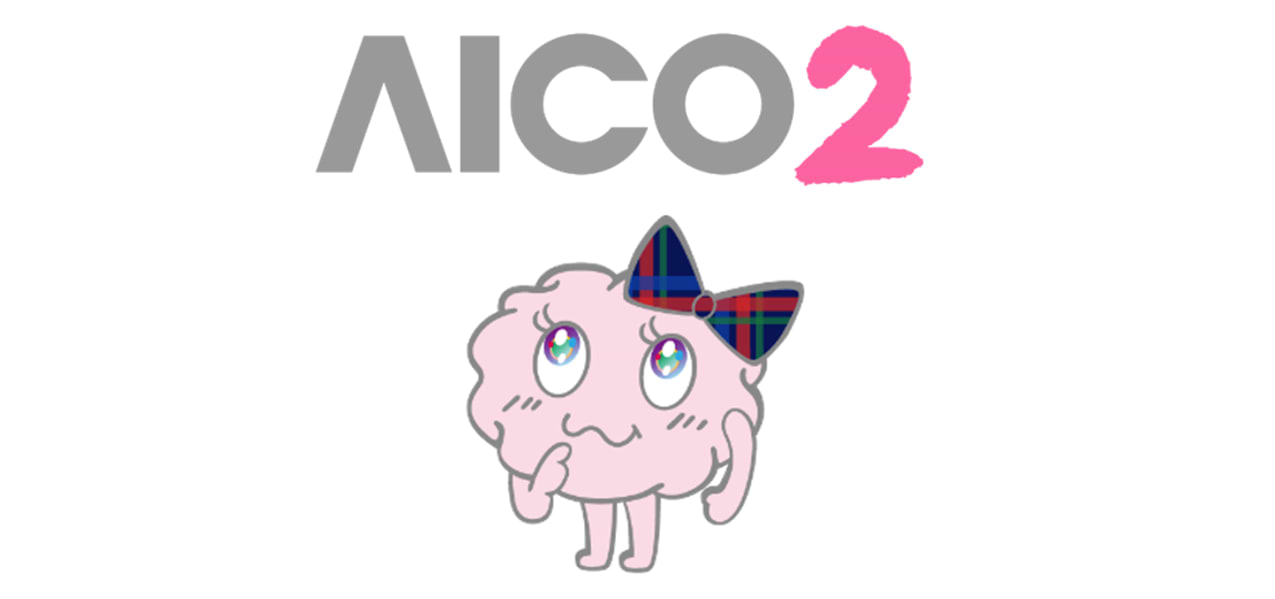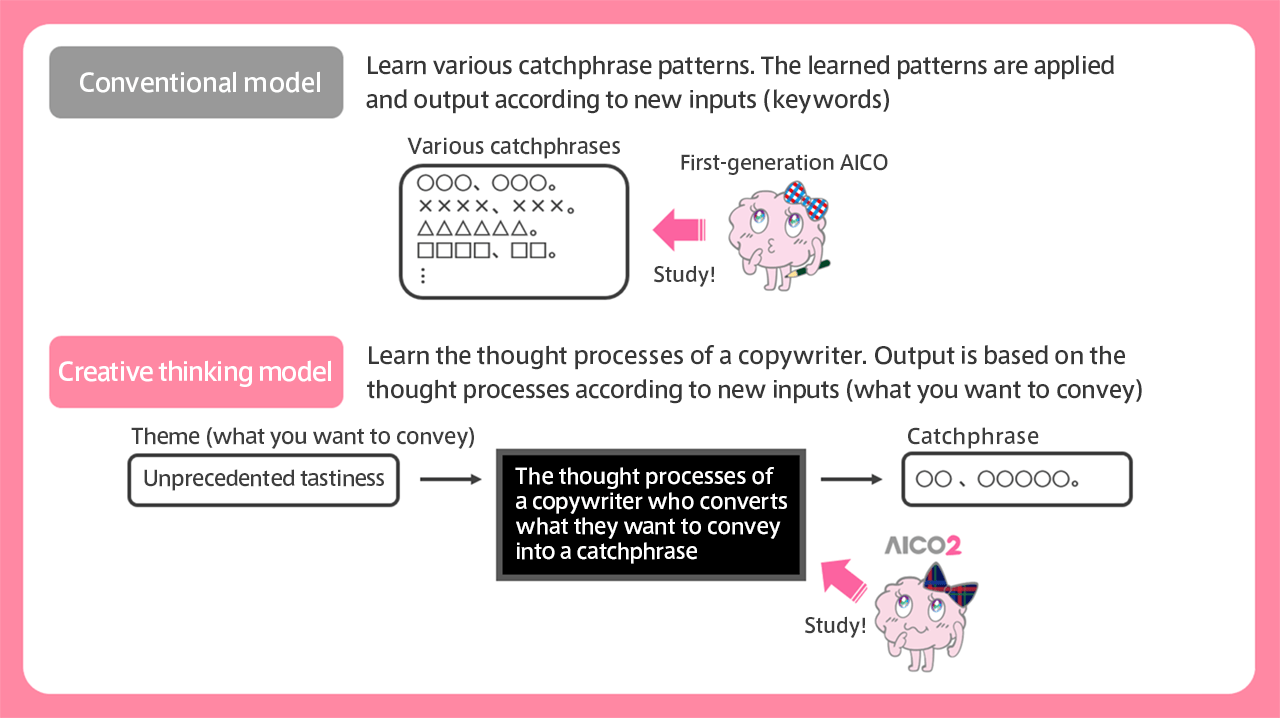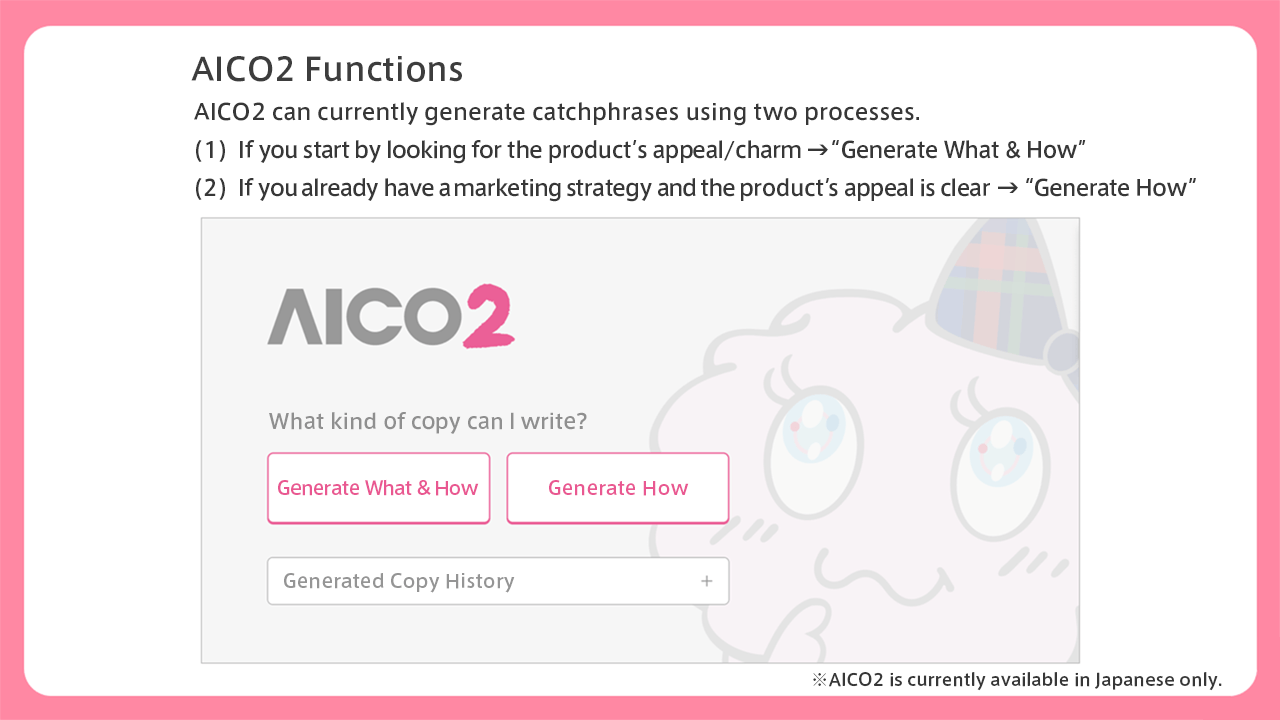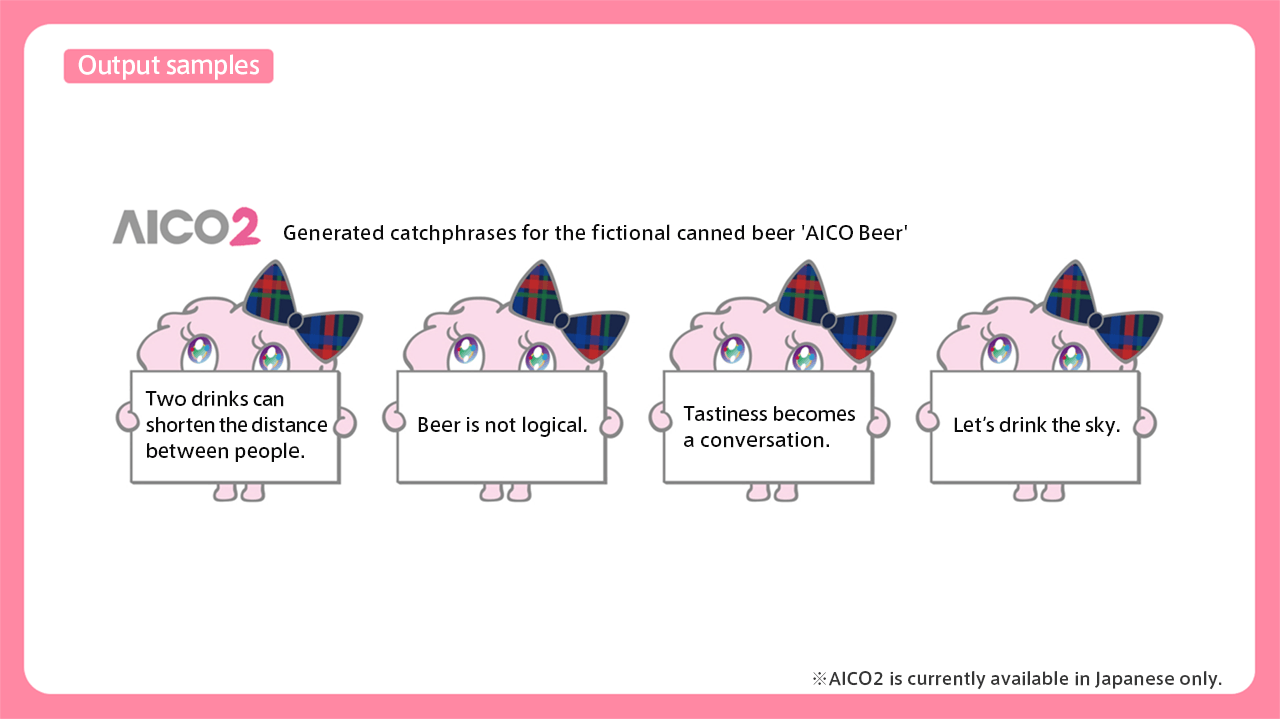
The story of the AICO copywriter to date
AICO is a unique dentsu system which uses AI to create advertising copy, and was developed at the end of 2015, when we started a joint development project with Shizuoka University’s Kano Laboratory. Over the following years, we produced and tested many prototypes while exploring ways of co-creation between humans and AI, and finally released the first AICO copywriter in 2017. The first-generation AICO has a track record of being used in numerous advertising productions and in 2019, AICO was featured as a copywriter in the Tokyo Copywriters Club (TCC) yearbook, which lists the best catchphrases of the year.
When you hear the term “AI copywriter,” you may see an image of humans taking it easy while leaving everything to AI, but we never intended to replace humans with the AICO copywriter. By combining the strengths of humans and AI, we aim to further expand and enhance the creativity of dentsu’s creatives and planners.
From AICO to AICO2. How has the AI copywriter evolved?
The first-generation AICO copywriter was based on so-called deep learning, and it learned a large number of catchphrase patterns and output copy ideas according to new inputs (keywords). However, our challenge was that the variation in advertising copy ideas was limited because the method of expression relied only on the data that was used for training the AICO copywriter.
The development background for AICO2 is the spread of large-scale language models (LLMs). In recent years, it has become common to create advertising copy using AI generated by LLMs such as ChatGPT. However, in order to create “copy that resonates with the heart,” it is not enough to use generative AI as is, and further evolution is required based on the wisdom and experience of copywriters. We believe that the essence of a copywriter is not to know a lot of copy, but to know how to write good copy, and we have therefore implemented our GPT-3.5 Turbo model that we created by fine-tuning the thought processes that dentsu’s copywriters have cultivated over many years. Fine-tuning in AI is generally described as “retraining part or all of a trained model that was pre-trained using one training dataset by using a different training dataset.” To put it simply, it means changing the way a GPT thinks and tuning its thought processes in a specific direction. In order to perform fine-tuning, AICO2 needed to learn not only the copy that the copywriters thought of, but also the intention and thought processes behind the writing of the copy.
After nearly three years of testing and development, AICO2 was finally put into practical use as an AI copywriter equipped with a “creative thinking model” that learned the thinking circuits of dentsu’s copywriters. In order to develop AICO2, the collective knowledge of dentsu employees is reflected in the process of learning their way of thinking . These are not catchphrases created for a specific client company, but ones that were devised for dentsu’s internal use, such as copy submitted as training assignments, entries for the human rights slogans* that are part of an initiative aimed at raising DEI awareness within the company, and entries for SDGs slogans.
| * | Every year since 1988, we have solicited human rights slogans from dentsu Japan employees and their families. This is an activity unique to our company, in which short messages written in a free style similar to advertising copy are collected. We receive nearly 5,000 submissions each year. |
|---|

Generate copy with What and How
AICO2 can currently generate catchphrases using two processes. If you want to start by looking for the product’s appeal and charm, use the “Generate What & How” function. If you enter details such as the product name or problem you want to solve, and detailed information about that problem, it will make suggestions for the things that you want to say (What to Say). If you select the one that you think is good and proceed to “Generate How,” it will suggest various catchphrases (How to Say). On the other hand, if you already have a marketing strategy and know what you want to say, use the “Generate How” feature. If you enter what you want to say “What to Say”, it will suggest catchphrases (How to Say).

Through collaboration between AI and humans, the thinking ability of creatives also grows
AICO2 suggests various catchphrases in this way, but this does not mean that humans can use the generated copy as is and do nothing with it. By combining the strengths of humans and AI, we aim to further expand and enhance the creativity of dentsu’s creatives and planners.
It is the job of humans to first give orientation on What and How to AICO2. The results generated by AICO2 will vary greatly depending on the What and How settings. In other words, in order to generate more accurate and high-quality ideas with AICO2, the “creative director’s thinking ability” that provides a good orientation on the human side will be strengthened.
An in-house copywriter who is actually using AICO2 commented:
“I feel like I am being looked into deeply when I’m using it.”
Other comments made included, “I feel like I am being forced to do things that I usually do on my own, things like ‘What is something?’, ‘What do I want to convey?’ and ‘What are the challenges?’”
Of course, selecting and arranging the copy that appears is also the work of humans. The copy generated by AICO2 comes with a “confidence” index that is calculated by self-rating the output copy, but even if the proposal has a low confidence level, being able to realize that “this is also a good way to approach it” and to pick things up is also unique to human thinking. How to utilize the results generated by AICO2 and generate good creative work depends entirely on the skills of humans. In this way, the creative process which is carried out while the creative is thinking and also having the AICO copywriter think, provides a further opportunity for the creative to grow in their thinking ability.

What’s next for AICO2?
In this way, AICO2 was developed to assist in-house creatives and planners in their thinking tasks, and so it is not a product sold outside of dentsu. However, we have already started developing services using AICO2 that can be used by clients. In October 2024, we launched the “AICO AUDIO AD PROJECT” for general use; this is a service that allows brands to easily create audio advertisements using AICO2. After the announcement, we received a great response from clients and received many enquiries.
However, AICO2 is not finished yet. Currently, catchphrases are generated from What and How, but we are continuing to develop and add the necessary functions to create even more memorable catchphrases.
Going forward, AICO2 will continue to grow together with creatives and planners to expand dentsu’s creativity.
